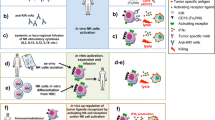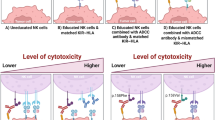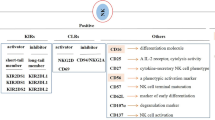Abstract
The purpose of this study was to determine the potential use of lymphokine-activated killer (LAK) cells against Kaposi's sarcoma (KS) cells. We used chromium release cold-target inhibition assay for understanding the expression of heterogeneous LAK-cell antigens (Ags) on KS cells, endothelial cells (ECs), and monocytes/macrophages (Mø) which could allow for the utilization of LAK-cell immunotherapy in KS without side effects. Our data show that (i) all three cell types express the CD18 Ag of LFA-1 or Leu-CAM, (ii) rare KS cells from eyes cannot cold target-inhibit ECs, (iii) KS cells express a distinct LAK-cell Ag, which we have called LAK-KS Ag, and (iv) LAK-KS Ag allows for cold-target inhibition between different KS cells. The identification of LAK-KS Ag and a monoclonal antibody capable of inhibiting lysis of ECs and Mø without obstructing LAK-KS Ag would be important.
Similar content being viewed by others
References
Gottlieb GJ, Ackerman AB (eds): Kaposi's Sarcoma: A Text and Atlas. Philadelphia: Lea & Febiger, 1988
Kaposi M: Idiopathisches multiples pigmentsarkom der haut Kaposi. Arch Dermatol Syph 4:265–273, 1872
Schwimmer EL: Sarcoma, idiopathische hautsarkom multiplex cutis (abstract). Monatschr Prakt Dermatol 9:90, 1899
Gilchrist TC, Ketron LW: Report of two cases of idiopathic hemorrhagic sarcoma (Kaposi), one presenting unusual features, with special methods of treatment and investigation. J Cutan Dis 34:429–440, 1916
Hashimoto H, Mueller H, Falk S, Stutte HJ: Histogenesis of Kaposi's sarcoma associated with AIDS: A histologic, immunohistochemical and enzyme histochemical study. Pathol Res Pract 182:658–668, 1987
Beckstead JH, Wood GS, Fletcher V: Evidence for the origin of Kaposi's sarcoma from lymphatic endothelium. Am J Pathol 119:294–300, 1985
Brooks JL: Hypothesis. Kaposi's sarcoma: A reversible hyperplasia. Lancet 2:1309–1311, 1986
Guarda LG, Silva EG, Ordonez NG, Smith Jr. JL. Factor VIII in Kaposi's sarcoma. Am J Clin Pathol 76:197–200, 1981
Modlin RL, Hofman FM, Kemf RA, Taylor CR, Conant MA: Kaposi's sarcoma in homosexual men: an immunohistochemical study. J Am Acad Dermatol 8:620–627, 1983
Jones RR, Spaull J, Spry C, Jones EW: Histogenesis of Kaposi's sarcoma in patients with and without acquired immune deficiency syndrome (AIDS). J Clin Pathol 39:742–749, 1986
Schulze HJ, Ruetten A, Mahrle G, Steigleder GK: Initial lesions of HIV-related Kaposi's sarcoma—a histological, immunohistochemical, and ultrastructural study. Arch Dermatol Res 279:499–503, 1987
Leu HJ, Schneider J, Hardmeier T, Maurer R, Leuthy R, Burger R, Burger HR, Krause M: Kaposi's sarcoma and malignant lymphoma in AIDS. Virchows Arch 403:205–213, 1984
Walter P, Philippe E, Khalil T, Nguemby-Mbina C, Chambian A: Kaposi's sarcoma: A vascular neoplasm of presumably viral origin; histologic and ultrastructural characteristics. Ann Pathol 4:19–25, 1984
Schenk P: Ultrastructural morphology of Kaposi's sarcoma of the head and neck in acquired immune deficiency syndrome (AIDS). Laryngol Rhinol Otol Stuttg 65:604–611, 1986
Grimm EA, Mazumder A, Zhang HZ, Rosenberg SA: Lymphokine-activated killer cell phenomenon: Lysis of natural killer-resistant fresh solid tumor cells by interleukin-2-activated autologous human peripheral blood lymphocytes. J Exp Med 155:1823–1841, 1982
Yang JC, Rosenberg SA: Current approaches to the adoptive immunotherapy of cancer. Adv Exp Med Biol 233:459–567, 1988
Grimm EA, Ramsey KM, Mazumder A, Wilson DJ, Djeu JY, Rosenberg SA: Lymphokine-activated killer cell phenomenon. II. Precursor phenotype is serologically distinct from peripheral T-lymphocytes, memory cytotoxic thymus-derived lymphocytes, and natural killer cells. J Exp Med 157:884–897, 1983
Clark JW, Longo DL: Adoptive therapies: Quo vadis? Pathol Immunopathol Res 7:442–458, 1988
Vercellotti GM, Kotasek D, Jocob HS: Excessive vulnerability of herpes-infected endothelium to lymphokine-activated lymphocytes: A possible role in lethal viral pneumonitis following bone marrow transplantation. Trans Assoc Am Phys 101:310–313, 1988
Kotasek D, Vercellotti GM, Ochoa AC, Bach FH, White JG: Mechanism of cultured endothelial injury induced by lymphokine-activated killer cells. Cancer Res 48:5528–5532, 1988
Streck RJ, Helinski EH, Ovak GM, Pauley JL: Lysis of autologous human macrophages by lymphokine-activated killer cells: Interaction of effector cell and target cell conjugates analyzed by scanning electron microscopy. J Leukocyte Biol 48:237–246, 1990
Zambello R, Trentin L, Feruglio C, Bulian P, Masciarelli M: Susceptibility of lysis of pulmonary alveolar macrophages by human lymphokine-activated killer cells. Cancer Res 50:1768–1773, 1990
Mazumder A, Grimm EA, Rosenberg SA: Lysis of fresh human solid tumor cells by autologous lymphocytes activatedin vitro by allosensitization. Cancer Immunol Immunother 15:1–10, 1983
Groscurth P: Cytotoxic effector cells of the immune system. Anat Embryol Berl 180:109–119, 1989
Grant AJ, Hall RE, Merchant RE: Binding of an antilymphocyte function associated antigen one (LFA-1) monoclonal antibody (RH1-38) to lymphokine activated killer (LAK) cells inhibits cytolytic capacity. (Abstract). J Leukocyte Biol 40:298, 1986
Niedt GW, Schinella RA: Acquired immunodeficiency syndrome: A clinicopathologic study of 56 autopsies. Arch Pathol Lab Med 109:727–734, 1985
Hui AN, Koss MN, Meyer PR: Necroscopy findings in acquired immunodeficiency syndrome: A comparison of premortem diagnoses with postmortem findings. Hum Pathol 15:670–676, 1984
Kotasek D, Vercellotti GM, Ochoa AC, Bach FH, Jacob HS: Lymphokine activated killer (LAK) cell-mediated endothelial injury: A mechanism for capillary leak syndrome in patients treated with LAK cells and interleukin-2. Trans Assoc Am Phys 100:21–27, 1987
Duke SS, King LS, Jones MR, Newman JH, Brigham KL: Human recombinant interleukin 2-activated sheep lymphocytes lyse sheep pulmonary microvascular endothelial cells. Cell Immunol 122:188–199, 1989
Sanchez-Madrid F, Nagy JA, Robbins E, Simon P, Springer TA: A human leukocyte differentiation antigen family with distinct α-subunits and a common β-subunit: The lymphocyte function-associated antigen (LFA-1), the C3bi complement receptor (OKMI/Mac-1) and the p150, 95 molecule. J Exp Med 158:1785–1803, 1983
Blanchard DK, Hall RE, Djeu JY: Role of CD18 in lymphokine activated killer (LAK) cell-mediated lysis of human monocytes: Comparison with other LAK targets. Int J Cancer 45:312–319, 1990
Patarroyo M, Prieto J, Rincon J, Timonen T, Lundberg C: Leukocyte-cell adhesion: A molecular process fundamental in leukocyte physiology. Immunol Rev 114:67–108, 1990
Blanchard DK, Michelini-Norris MB, Freidman H, Djeu JY: Lysis of mycobacteria-infected monocytes by IL-2-activated killer cells: Role of LFA-1. Cell Immunol 119:402–411, 1989
Zocchi MR, Faravelli A, Gianazza E, Pardi R, Rugarli C: LAK1: A novel leucocyte differentiation antigen shared by lymphoid and endothelial cells. Basic Appl Histochem 34:43–50, 1990
Author information
Authors and Affiliations
Rights and permissions
About this article
Cite this article
Rahman, M.U., Mazumder, A. Recognition of heterogeneous lymphokine-activated killer (LAK) receptors on Kaposi's sarcoma cells, endothelial cells, and monocytes/macrophages: Evidence of distinct LAK-cell antigen on Kaposi's sarcoma cells—Potential for use of LAK cells for immunotherapy. J Clin Immunol 12, 281–288 (1992). https://doi.org/10.1007/BF00918152
Accepted:
Issue Date:
DOI: https://doi.org/10.1007/BF00918152




